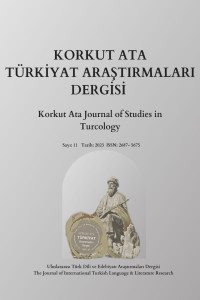Abstract
The Sufi movement started with Ahmed-i Yesevî in Central Asia and spread to Haci Bektash Veli, Yunus Emre, etc. in Anatolia. Sustained by the Mystics. Ahmed-i Yesevî's understanding of "Four Doors and Forty Positions" has been a source for many Sufi people. The four doors and forty positions are the material and spiritual stages that the disciple will pass through. A person who strives to be a perfect human being aims to reach Allah by passing the four doors and forty positions.
Hacı Bektaş-ı Veli, one of the important figures of religious-mystical Turkish literature in Anatolia and accepted as the founder of Bektashism, adopted the understanding of four doors and forty positions in her work called Makalât, with the influence of Ahmed-i Yesevî. Within the framework of this understanding, he made various suggestions. This understanding has continued by being transferred from generation to generation for centuries and has preserved its actuality. In the Dîvân of Kadîmî Baba, a Bektashi father who lived in the 20th century, there are four doors and forty positions with the influence of Haci Bektash Veli.
In our study, the understanding of four doors and forty positions in the Divan of Kadîmî Baba, a Bektashi father living in the 20th century, was tried to be determined. The detected examples in question were discussed in detail and tried to be examined.
References
- Akarpınar, R. B. ve Arslan, M. (2008). Tekke-Tasavvuf Edebiyatı. Türk Halk Edebiyatı El Kitabı (ed. Mehmet Öcal Oğuz). Ankara: Grafiker Yayınları, s. 279-324.
- Aytaş, G. (2020). Alevi-Bektaşi Dünyası İnceleme ve Değerlendirmeler. Ankara: Akçağ Yayınları.
- Çakır, M. (2015). Kadîmî Baba (Ali Rıza Öge) Hayatı ve Şiirleri. Ankara: Akçağ Yayınları.
- Çift, S. (2020). Ahmed Sırrı Baba. TDV İslâm Ansiklopedisi (C. 1, s. 52-53). İstanbul: TDV Yayınları.
- Gökbel, A. (2019). Ansiklopedik Alevi Bektaşi Terimleri Sözlüğü. Ankara: Atatürk Kültür Merkezi Başkanlığı Yayını.
- Güzel, A. (2002). Hacı Bektaş Velî ve Makâlât. Ankara: Akçağ Yayınları.
- Güzel, A. (2006). Dinî-Tasavvufi Türk Edebiyatı. Ankara: Akçağ Yayınları.
- Kandemir, M. Y. (1994). Ebû Türâb. TDV İslâm Ansiklopedisi. (C. 10, s. 243). İstanbul: TDV Yayınları.
- Keleş, R. (2013). Divan Şiirinde Lafzî Âyet ve Hadis İktibasları. Doktora Tezi. Erzurum: Atatürk Üniversitesi.
- Kubbealtı Lügati: http://lugatim.com [Erişim tarihi: 02.03.2023]
- Kur’ân-ı Kerîm ve Açıklamalı Meâli. (2005). Türkiye Diyanet Vakfı.
- Kur’an-ı Kerim. (2023). Diyanet İşleri Başkanlığı. https://kuran.diyanet.gov.tr/tefsir/Bakara-suresi/122/115-ayet [Erişim tarihi: 17.04.2023]
- Noyan, B. (2003). Bütün Yönleriyle Bektaşilik ve Alevîlik. C. VI. Ankara: Ardıç Yayınları.
- Özcan, H. (2007). Alevî/Bektaşi İnancına Bakışlar. İstanbul: Fatih Üniversitesi Yayınları.
- Tavukçu, O. K. (2022). Yûnus Emre ve Dîvân’ı. İstanbul: VakıfBank Kültür Yayınları.
- Üstüner, K. (2014). Tasavvuf ve Klasik Şiirimiz. Ankara: Akçağ Yayınları
Abstract
Tasavvuf hareketi, Orta Asya’da Ahmed-i Yesevî ile başlayıp Anadolu’da Hacı Bektaş-ı Veli, Yunus Emre vb. mutasavvıflar tarafından sürdürülmüştür. Ahmed-i Yesevî’nin “Dört Kapı Kırk Makam” anlayışı, pek çok tasavvuf ehline kaynaklık etmiştir. Dört kapı kırk makam, müridin geçeceği maddi ve manevi aşamalardır. İnsan-ı kâmil olma yolunda çaba gösteren kişi, dört kapı kırk makamı geçerek Allah’a ulaşmayı amaçlar.
Dinî-tasavvufi Türk edebiyatının Anadolu’daki mühim temsilcilerinden biri olan ve bunun yanında Bektaşiliğin kurucusu olarak kabul edilen Hacı Bektaş-ı Veli, Ahmed-i Yesevî’nin tesiri altında kalarak Makâlât adlı eserinde, dört kapı kırk makam anlayışını benimsemiştir. Bu anlayış çerçevesinde çeşitli telkinlerde bulunmuştur. Söz konusu anlayış, yüzyıllarca kuşaktan kuşağa aktarılarak devam etmiş ve güncelliğini muhafaza etmiştir. XX. yüzyılda yaşamış bir Bektaşi babası olan Kadîmî Baba’nın Dîvân’ında da Hacı Bektaş-ı Veli’nin tesiriyle dört kapı kırk makam anlayışı vardır.
Çalışmamızda XX. yüzyılda yaşayan bir Bektaşi babası olan Kadîmî Baba’nın Dîvân’ında bulunan dört kapı kırk makam anlayışı tespit edilmeye çalışılmıştır. Dîvân’da tespit edilen örnekler detaylı bir şekilde incelenmiştir.
References
- Akarpınar, R. B. ve Arslan, M. (2008). Tekke-Tasavvuf Edebiyatı. Türk Halk Edebiyatı El Kitabı (ed. Mehmet Öcal Oğuz). Ankara: Grafiker Yayınları, s. 279-324.
- Aytaş, G. (2020). Alevi-Bektaşi Dünyası İnceleme ve Değerlendirmeler. Ankara: Akçağ Yayınları.
- Çakır, M. (2015). Kadîmî Baba (Ali Rıza Öge) Hayatı ve Şiirleri. Ankara: Akçağ Yayınları.
- Çift, S. (2020). Ahmed Sırrı Baba. TDV İslâm Ansiklopedisi (C. 1, s. 52-53). İstanbul: TDV Yayınları.
- Gökbel, A. (2019). Ansiklopedik Alevi Bektaşi Terimleri Sözlüğü. Ankara: Atatürk Kültür Merkezi Başkanlığı Yayını.
- Güzel, A. (2002). Hacı Bektaş Velî ve Makâlât. Ankara: Akçağ Yayınları.
- Güzel, A. (2006). Dinî-Tasavvufi Türk Edebiyatı. Ankara: Akçağ Yayınları.
- Kandemir, M. Y. (1994). Ebû Türâb. TDV İslâm Ansiklopedisi. (C. 10, s. 243). İstanbul: TDV Yayınları.
- Keleş, R. (2013). Divan Şiirinde Lafzî Âyet ve Hadis İktibasları. Doktora Tezi. Erzurum: Atatürk Üniversitesi.
- Kubbealtı Lügati: http://lugatim.com [Erişim tarihi: 02.03.2023]
- Kur’ân-ı Kerîm ve Açıklamalı Meâli. (2005). Türkiye Diyanet Vakfı.
- Kur’an-ı Kerim. (2023). Diyanet İşleri Başkanlığı. https://kuran.diyanet.gov.tr/tefsir/Bakara-suresi/122/115-ayet [Erişim tarihi: 17.04.2023]
- Noyan, B. (2003). Bütün Yönleriyle Bektaşilik ve Alevîlik. C. VI. Ankara: Ardıç Yayınları.
- Özcan, H. (2007). Alevî/Bektaşi İnancına Bakışlar. İstanbul: Fatih Üniversitesi Yayınları.
- Tavukçu, O. K. (2022). Yûnus Emre ve Dîvân’ı. İstanbul: VakıfBank Kültür Yayınları.
- Üstüner, K. (2014). Tasavvuf ve Klasik Şiirimiz. Ankara: Akçağ Yayınları
Details
| Primary Language | Turkish |
|---|---|
| Subjects | Creative Arts and Writing |
| Journal Section | Araştırma Makaleleri |
| Authors | |
| Publication Date | June 30, 2023 |
| Submission Date | April 17, 2023 |
| Published in Issue | Year 2023 Issue: 11 |

